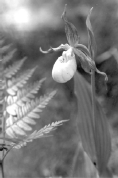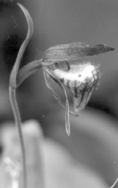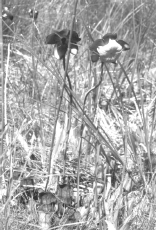OFF ROAD
(photos by Nancy Thumser)
|
|
|
|
Twenty miles north of Alpena, off US 23, is a Michigan State Park called Thompson’s Harbor. It’s a long, potholed road into the parking lot, but if you go there around Memorial Day, you’ll be greeted by a profusion of wild flowers before you even get out of the car—Yellow Lady’s-Slippers (a large and stunning wild orchid), red Columbine, and tiny purple Dwarf Lake Iris (a threatened species that grows exclusively on the shores of Lakes Michigan and Huron, and was recently named our state wildflower). The footpath follows an old road of crushed shells and pebbles, leading you slowly toward the rocky Lake Huron shoreline. On the way, if you look closely (and carry a flower identification book), you might spot the tiny Birdseye Primrose, the oddly named Fringed Polygala, and possibly even the elusive Ram’s-Head Lady’s-Slipper (a tiny white orchid with purple stripes).
My husband Jeff and I have seen all these flowers, and more, on just one late May walk in this preserved shoreline property. Many of them are protected Michigan wildflowers that we’ve rarely seen growing anywhere else. We’ve enjoyed the quiet of this out-of-the-way walk and the sunny expanse of undeveloped land opening up to endless fresh water.
One year, in such a blissful reverie, we stopped to look at an area where the lake meets the shore in the form of a strange bog. Rust-colored reed grasses grow thick on springy mud and peat moss, while abundant dark-red Pitcher Plant flowers mingle with the bright red blooms of Indian Paintbrush. The flowers and grasses reach all the way to the lake, but the footpath stops right where the marsh begins; it’s too wet and fragile to explore. The scene is worthy of a Van Gogh painting. I was awed by the varied species living together, just doing their thing, year after year, whether we’re there to see it or not.
After gazing a while, we moved further down the path, to a stretch of shoreline made of large rocks revealed by the low water level of the lake. Not another human soul was visible in any direction. We sat down and knowingly broke the rules by popping open a bottle of champagne to celebrate being on vacation. (We planned to take our garbage back out with us, of course.)
The moment would have been perfect except for the loud grinding motors of a group of off-road vehicles in the distance: thrill-seekers on four-wheelers, "enjoying" the outdoors by grinding up the ground, spewing fumes, and disturbing the peace.
"Well, at least we have this special place," I said, toasting Thomson’s Harbor.
An hour or so later, we arose and headed back the way we’d come. But when we rounded a bend in the path that opened to the bog, you can’t imagine our horror. Tire ruts, two feet deep, cut through, across, and all over the wetlands. Many of the flowers were crushed or torn up by the roots. Puddles of muddy water had filled in where the grasses were now gone. We stood there slack-jawed. Ugliness, destruction, ignorance, waste. I nearly threw-up. All the effort to grow and bloom and reproduce, all the years of stabilizing the soil with their roots, all the post-winter months of re-birth, gone in an instant of foolish human vanity.
The four-wheelers were nowhere in sight. But even if they had been, what could two pacifist hikers have done about it? I didn’t want a confrontation. I just wanted them to cut their engines, kneel down on the ground, and take a look at the unusual details of the Pitcher Plant, which grows cups to catch water and insects for nourishment. And to marvel at the sticky hairs on the minute, carnivorous Sundews—like tiny Venus Flytraps—that grow at the base of the Pitcher Plants. I wanted them to know that these amazing species are perfectly adapted to the watery bogs where they live, and that there aren’t many places left where such specialized plants can make themselves at home.
I know it’s a ridiculous fantasy. I know that users of off-road vehicles (ORVs) have established powerful associations and lobbies to maintain or increase access to wild lands all over this country. I know that many ORVs (including snowmobiles and jet-skis) expel 25-30 percent of their oil and gasoline unburned into the air and water, and more people keep buying them anyway. I know that more than twenty years ago, the federal government recognized that ORVs were damaging every kind of ecosystem found in the U.S., from sand dunes to prairie grasslands to alpine meadows to arctic tundras. And since that time, ORV use has grown dramatically, leading the Wilderness Society to call them "the single fastest growing threat to the natural integrity of our public lands."
The rest of the walk out of the park that day was painfully quiet. I was both grieving and seething, and I know Jeff was too. The reality of such thoughtlessness was a heavy burden to carry. Sure, we need better policies to declare wild lands off limits to off-road vehicles, but that clearly won’t solve the problem. After all, Thompson’s Harbor is protected, but nobody is there to enforce the rules. People will have to care enough about the land to choose to do something different with their recreation time than driving over fragile bogs.
I understand that my love affair each spring with wildflowers is an acquired taste that even my family thinks is a little odd. But I don’t know how we’ll have any hope of making better environmental decisions or changing destructive human behaviors until people truly fall in love with the wild life around us. We need to become thrill-seekers in a new way, discovering how thrilling nature can be when you simply stop to look at it.
Signed Elements ©
Individual Authors
Unsigned Elements © Agenda Publications, LLC


